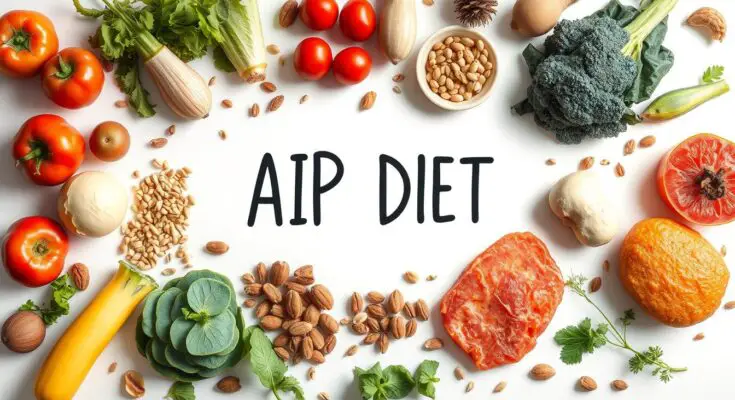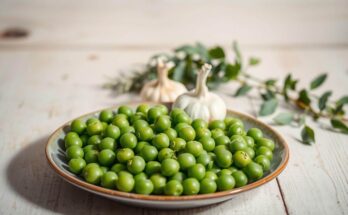Discover what the AIP diet is, how it works, and its benefits for autoimmune conditions. Learn about allowed foods, meal plans, and tips to get started on this healing protocol.
The Autoimmune Protocol (AIP) diet is a way to manage autoimmune diseases. It removes foods that can cause inflammation and helps heal the body.
By following an AIP diet, people may feel better from chronic pain and fatigue. This diet focuses on eating foods that are good for your health.
This diet removes foods that might cause inflammation. Then, it slowly adds them back to see how the body reacts. This helps people make better food choices.
What Is The AIP Diet: A Comprehensive Overview
The Autoimmune Protocol (AIP) diet is a detailed elimination diet. It aims to reduce inflammation and help the body heal.
Definition and Purpose
The AIP diet helps manage autoimmune diseases by removing foods that might cause inflammation. It focuses on eating foods that are full of nutrients. Its main goal is to reduce inflammation and help the body heal.
Key parts of the AIP diet include:
- Eliminating grains, dairy, legumes, added sugars, and processed foods
- Eating nutrient-dense foods like meats, fish, fruits, and vegetables
- Staying away from nightshades and other foods that might irritate
Origins and Development
The AIP diet is closely tied to the paleo diet. It has similar rules but adds more restrictions for autoimmune conditions. Experts in nutrition and autoimmune diseases created it. They built on the paleo diet to make a more tailored plan.
The Science Behind Autoimmune Conditions
Autoimmune conditions involve complex relationships between the immune system, gut health, and overall health. These diseases happen when the body’s immune system attacks its own cells and tissues. This leads to various health problems. Understanding this is key to seeing how the AIP diet helps manage these conditions.

How Autoimmunity Works
Autoimmunity is when the immune system can’t tell the difference between self and non-self. This leads to an immune response against the body’s own tissues. This can cause diseases like rheumatoid arthritis, lupus, and Hashimoto’s thyroiditis. The exact causes are not fully known, but genetics, environmental triggers, and gut health are thought to play a role.
The immune system’s response in autoimmunity can cause inflammation and damage to tissues and organs. For example, in autoimmune thyroiditis, the immune system attacks the thyroid gland. This disrupts its ability to make hormones. Knowing how autoimmunity works is important for finding effective ways to manage it, like the AIP diet, which aims to reduce inflammation and promote healing.
The Gut-Immune System Connection
The gut and the immune system are closely linked. A lot of the immune system is in the gut-associated lymphoid tissue (GALT). The health of the gut microbiome is important for immune function. Changes in the gut microbiota, known as dysbiosis, are linked to autoimmune conditions. The AIP diet focuses on gut health by removing foods that might irritate it and promoting nutrient-dense foods that help heal the gut lining and balance the gut microbiome.
By improving gut health and reducing exposure to potential triggers, the AIP diet aims to modulate the immune system. This can reduce the severity of autoimmune symptoms. This approach shows how important gut health, immune function, and overall well-being are. It highlights the benefits of dietary changes in managing autoimmune diseases.
Core Principles of the AIP Diet
The AIP diet is based on a simple yet strict principle: to heal the body by removing harmful foods and adding them back in a controlled way. This helps people find and manage dietary triggers that may worsen their autoimmune conditions.
The AIP diet has two main phases: elimination and reintroduction. Understanding these phases is key to successfully following the diet and getting its benefits.
Elimination Phase Explained
The elimination phase is the first and strictest part of the AIP diet. People must remove foods that can trigger inflammation and autoimmune issues for at least 30 days. This phase aims to calm the immune system, reduce inflammation, and start the healing process. Foods to avoid include grains, legumes, dairy, processed foods, nightshades, eggs, nuts, and seeds.
To succeed in the elimination phase, focus on eating foods rich in nutrients like meats, fish, fruits, and veggies. Meal planning is key to avoid forbidden foods and stay on track. An AIP meal plan might include breakfasts like cooked meats and fruit, lunches like grilled fish with roasted veggies, and dinners like slow-cooked stews with compliant ingredients.
Reintroduction Phase Strategy
After the elimination phase, the reintroduction phase starts. This phase involves adding back eliminated foods one at a time to check for reactions. The reintroduction phase is critical for figuring out which foods are safe and which to avoid. It’s best to start with foods less likely to cause reactions.
When reintroducing foods, add them one at a time, waiting a few days before adding another. This helps identify any foods that cause a reaction. Keeping a detailed food diary during this phase can be incredibly helpful in tracking reactions and making informed decisions about which foods to include or exclude from the diet long-term.
By carefully following the elimination and reintroduction phases, individuals can fully benefit from the AIP diet. This can help manage autoimmune conditions and improve overall health.
Foods to Avoid on the AIP Diet
The AIP diet requires careful consideration of foods that can trigger or worsen autoimmune responses. By knowing which foods to avoid, individuals can better manage their condition and potentially reduce symptoms associated with autoimmunity.
Inflammatory Foods
Certain foods can promote inflammation in the body, making autoimmune conditions worse. Processed foods often contain additives and preservatives that can trigger or worsen inflammation. Foods high in sugar and unhealthy fats can also contribute to inflammation.
Examples of inflammatory foods to avoid on the AIP diet include:
- Processed meats
- Refined sugars
- Dairy products containing additives
Common Allergens and Irritants
Common allergens and irritants can also trigger autoimmune responses. Foods like gluten, found in wheat, barley, and rye, and certain dairy proteins can be problematic. Avoiding these foods can reduce the immune system’s workload and potentially lessen autoimmune symptoms.
Nightshades and Other Specific Exclusions
The AIP diet also advises avoiding nightshades, including tomatoes, peppers, and eggplant, as they can cause inflammation in some. Other specific exclusions may include certain seafood and eggs, based on individual tolerance and sensitivity.
AIP Diet Approved Foods
The AIP diet focuses on nutrient-dense foods that promote healing and reduce inflammation. By eating whole, unprocessed foods, individuals can support their health and potentially alleviate autoimmune symptoms.

Nutrient-Dense Options
Nutrient-dense foods are key to the AIP diet. Organ meats are rich in vitamins A and D, iron, and other essential nutrients. Fatty fish, like salmon, are recommended for their omega-3 content, which supports heart health and reduces inflammation.
Other nutrient-dense options include leafy greens like spinach and kale, which are packed with vitamins and minerals. Fresh fruits, in moderation, provide essential vitamins, minerals, and antioxidants.
Healing Foods to Emphasize
Certain foods on the AIP diet are great for healing. Bone broth is full of collagen, which is good for your gut and joints. Probiotic-rich foods, like fermented veggies, keep your gut healthy.
Healthy fats in coconut oil and avocados fight inflammation. These foods nourish and help heal your body.
Supplements to Consider
While whole foods are best, some supplements can help on the AIP diet. Omega-3 supplements reduce inflammation, which is good for those who don’t eat enough fatty fish. Probiotics support gut health, mainly during the elimination phase.
Always talk to a healthcare provider before taking supplements. Everyone’s needs are different.
AIP Diet vs. Paleo Diet: Key Differences
It’s important to know the differences between the AIP and Paleo diets if you’re managing autoimmune diseases with diet. Both diets focus on whole, nutrient-rich foods. But they have different approaches and restrictions.
Similarities Between the Diets
Both diets remove grains, dairy, legumes, and processed foods. They focus on meats, fish, fruits, and veggies. This is because these foods can be inflammatory for some, making autoimmune conditions worse. The emphasis on whole foods reduces exposure to harmful additives and preservatives.
- Elimination of grains and legumes
- Focus on meats, fish, and seafood
- Emphasis on fruits and vegetables
How AIP Is More Restrictive
The AIP diet is stricter than the Paleo diet. It removes foods that could cause inflammation or irritation, like nightshades, eggs, and certain seeds and nuts. This stricter approach helps identify and manage specific food triggers that may worsen autoimmune symptoms.
- Additional elimination of nightshades and eggs
- Stricter guidelines for reintroduction
- Focus on healing and gut restoration
Creating an AIP Meal Plan
Creating an AIP meal plan means understanding the diet’s core principles. The Autoimmune Protocol diet aims to manage autoimmune conditions by removing inflammatory foods and focusing on nutrient-dense options.
To begin, learn which foods are allowed and which to avoid on the AIP diet. This knowledge is key to creating a compliant and effective meal plan.
Breakfast Ideas
Breakfast on the AIP diet can be varied and tasty. Some ideas include:
- Scrambled eggs with spinach and avocado
- AIP-compliant smoothies made with coconut milk and frozen berries
- Grilled meats or fish served with sautéed vegetables
These options give you a nutrient-rich start to the day, supporting your health and diet compliance.
Lunch and Dinner Options
For lunch and dinner, include a variety of healing foods in your meals. Some suggestions are:
- Grilled or baked meats served with roasted vegetables
- Soups made with bone broth and a variety of vegetables
- Salads with grilled meats or fish, topped with AIP-friendly dressings
These meals are not only AIP-compliant but also packed with nutrients to support healing and well-being.
Snacks and Treats
Snacking on the AIP diet can be fun and easy. Here are some ideas:
- Fresh or dried fruits
- Vegetable sticks with compliant dips
- AIP-friendly desserts made with coconut milk or gelatin
These snacks and treats can help you stay on track and satisfy cravings. This makes the AIP diet more enjoyable and manageable.
By adding these ideas to your AIP meal plan, you can keep your diet balanced and compliant. This is key for managing autoimmune conditions.
Common Challenges and How to Overcome Them
Following the AIP diet requires understanding its principles and finding ways to overcome common challenges. People on this diet often face obstacles that test their commitment. They need creative solutions to overcome these challenges.
Social Situations and Dining Out
Social events and dining out can be tough on the AIP diet. To handle these situations, planning ahead is key. This might mean eating before you go or bringing your own AIP-compliant dishes.
- Research restaurants that can accommodate AIP dietary needs.
- Call ahead to confirm that the restaurant can prepare AIP-friendly meals.
- Be prepared to explain the AIP diet to servers or chefs if necessary.
Maintaining Compliance Long-Term
Staying on the AIP diet long-term can be hard because it’s so restrictive. But focusing on the benefits experienced and finding variety in allowed foods can keep you motivated.
- Explore new recipes to keep meal plans interesting.
- Connect with others following the AIP diet for support.
- Reward progress with non-food related treats.
Working with Healthcare Providers
It’s important to work closely with healthcare providers when starting the AIP diet, even more so for those with severe autoimmune conditions. They can guide you on monitoring progress and making necessary adjustments.
- Schedule regular check-ins to monitor health improvements.
- Discuss any challenges or concerns with your healthcare provider.
- Adjust your diet plan based on professional advice.
Is the AIP Diet Right for You?
Choosing to follow the AIP diet is a personal decision. It depends on your health goals and needs. The AIP diet is a more restrictive version of the paleo diet. It eliminates more food groups to reduce inflammation and promote healing.
To decide if the AIP diet is for you, think about your health, dietary preferences, and lifestyle. If you have chronic inflammation, autoimmune symptoms, or digestive issues, the AIP diet might help.
Before making big changes to your diet, talk to a healthcare professional. They can discuss the potential benefits and challenges with you. They can also help you create a personalized plan that fits your needs and ensures a safe transition to the AIP diet.




